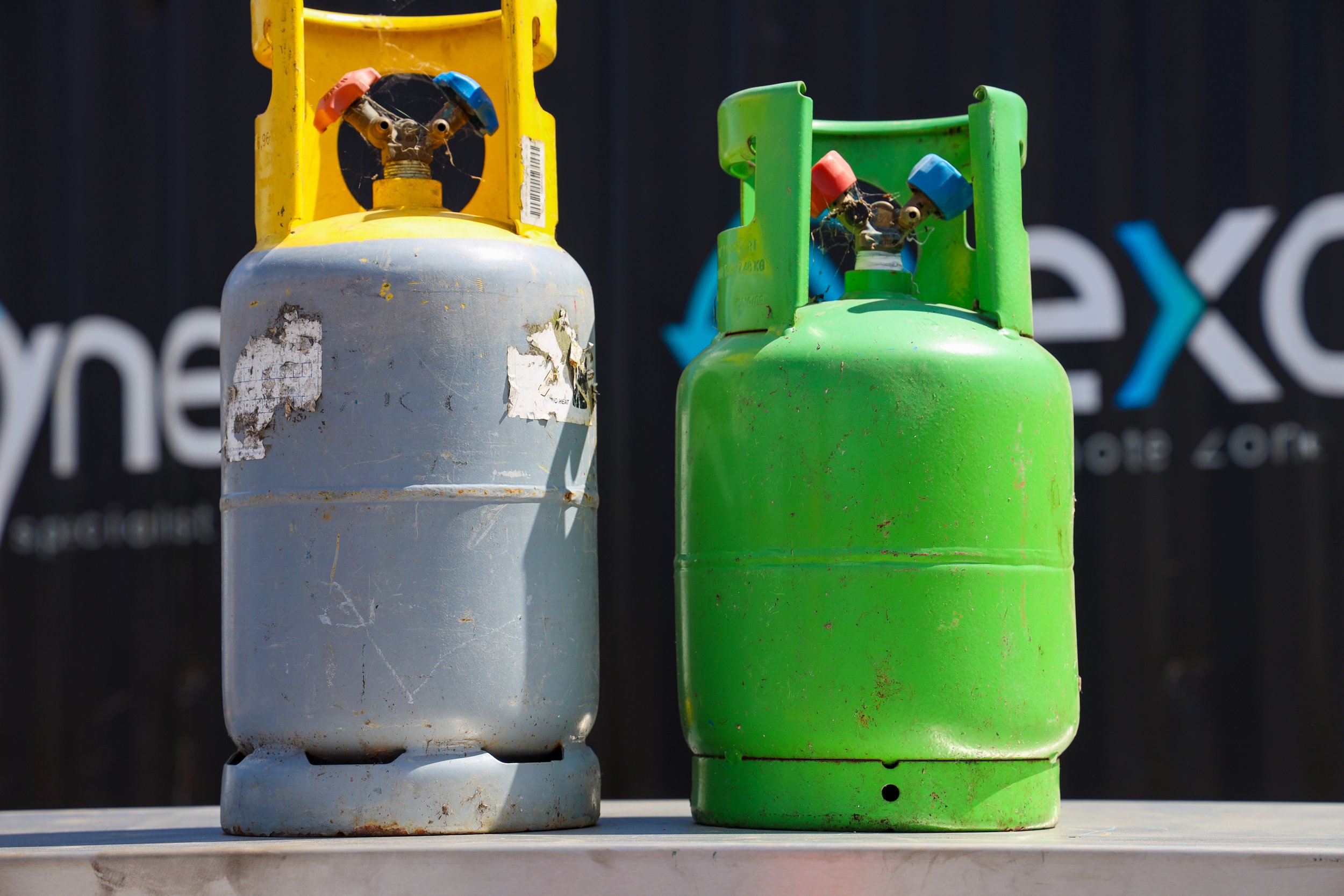Synergy can disposes of Refrigerants
Overview
Chemical Composition: Refrigerants are a diverse group of substances, typically composed of fluorocarbons, chlorofluorocarbons (CFCs), hydrochlorofluorocarbons (HCFCs), and hydrofluorocarbons (HFCs).
Description: Refrigerants are used in various cooling applications, including air conditioning systems, refrigerators, and industrial cooling processes. They work by absorbing heat during evaporation and releasing it during condensation.
Label Information
Contents: The canisters contain various types of refrigerants, such as R-134a (tetrafluoroethane), R-22 (chlorodifluoromethane), R-410A (a blend of difluoromethane and pentafluoroethane), among others.
UN Numbers:
R-134a: UN 3159
R-22: UN 1018
R-410A: UN 3163
Purpose of UN Numbers: These numbers identify specific refrigerants for transport and emergency response purposes.
Hazard Symbols:
Non-Flammable Gas Symbol: Many refrigerants are non-flammable and carry this symbol.
Warning Information:
Asphyxiation Risk: Refrigerants can displace oxygen in confined spaces, posing an asphyxiation risk.
Handling Instructions: Handle with care to avoid leaks and ensure proper ventilation. Use appropriate protective equipment.
Emergency Procedures: Labels may include first aid instructions in case of exposure, such as moving the affected individual to fresh air and seeking immediate medical attention.
Physical and Chemical Properties:
Appearance: Colourless gases or liquids.
Odour: Slightly sweet odour for some, while others are odourless.
Boiling Points: Varies by refrigerant (e.g., R-134a: -26.3°C, R-22: -40.7°C, R-410A: -51.6°C)
Density: Heavier than air, varying densities depending on the specific refrigerant.
Molecular Weights: Vary depending on the specific refrigerant.
Health Effects:
Acute Exposure: Inhalation of high concentrations can lead to dizziness, headaches, confusion, loss of consciousness, and in extreme cases, death due to oxygen displacement.
Chronic Exposure: Prolonged exposure can lead to long-term health effects, such as heart arrhythmias and central nervous system issues.
Skin and Eye Contact: Liquid refrigerants can cause frostbite due to their low boiling points.
Reactivity and Compatibility:
Reactivity: Refrigerants are generally stable but can decompose at high temperatures, producing toxic and corrosive byproducts like hydrogen fluoride and carbonyl halides.
Incompatible Materials: Avoid contact with strong oxidizing agents and open flames.
Environmental Impact:
Ozone Depletion: Older refrigerants like CFCs and HCFCs contribute to the depletion of the ozone layer.
Global Warming: Many modern refrigerants, especially HFCs, are potent greenhouse gases with high global warming potentials (GWP). Efforts are being made to phase out these refrigerants in favor of more environmentally friendly alternatives.
Applications:
Air Conditioning: Used in residential, commercial, and automotive air conditioning systems.
Refrigeration: Employed in household refrigerators, freezers, and industrial refrigeration systems.
Heat Pumps: Utilized in heat pump systems for both heating and cooling applications.
Safety Measures:
Storage: Store in a cool, dry, and well-ventilated place away from incompatible substances. Ensure that storage areas are equipped with proper ventilation and leak detection systems.
Handling: Use appropriate leak detection methods and regularly inspect equipment. Handle with care to prevent leaks and spills. Use in areas with proper ventilation to avoid oxygen displacement.
Protective Equipment: Use personal protective equipment (PPE) such as gloves, eye protection, and adequate ventilation when handling refrigerants. Ensure that all personnel are trained in handling gases and emergency response procedures.
Regulatory Information:
Occupational Exposure Limits: Various regulatory bodies have established guidelines for safe exposure levels to protect workers from the harmful effects of refrigerant gases.
Transport Regulations: When transporting refrigerants, they must be properly labeled and packaged according to international regulations, such as those set by the International Air Transport Association (IATA) and the International Maritime Organization (IMO).
Phase-Out Regulations: Many older refrigerants like CFCs and HCFCs are being phased out under international agreements like the Montreal Protocol due to their environmental impact.
Refrigerants are essential for cooling applications but come with significant health and environmental risks. Proper handling, storage, and usage instructions are critical to prevent leaks and ensure safety. Adequate ventilation, appropriate protective equipment, and adherence to safety protocols are essential when using or storing these gases. Always refer to the manufacturer's guidelines and emergency procedures.


